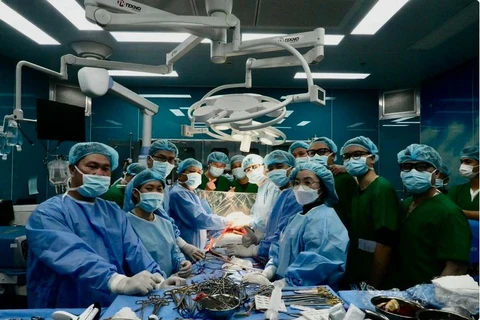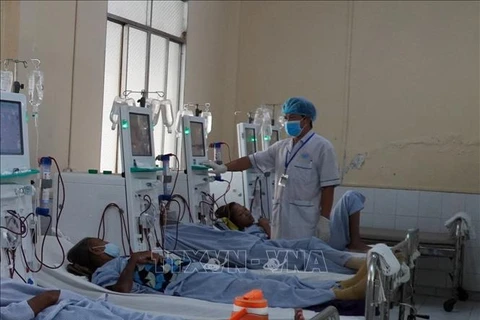Hanoi (VNS/VNA) - Vietnam will upgrade six hospitals to international standards, aiming to curb the trend of Vietnamese people seeking medical care overseas, and at the same time, attracting foreign patients to Vietnam.
In a visionary move outlined in the healthcare network plan in the 2021-30 period, recently endorsed by the Prime Minister Pham Minh Chinh, Vietnam envisions six hospitals in Hanoi, HCM City and Thua Thien-Hue attaining global recognition for their advanced medical facilities.
Under this strategic plan, Hanoi will have three state hospitals, two in HCM City and one for Thua Thien-Hue.
Earlier, the Ministry of Health (MoH) recommended the modernisation of five specialised hospitals to meet international starndard, rivalling leading healthcare systems in the region and beyond.
These include Bach Mai Hospital, Viet Duc Hospital, Military Hospital 108, Cho Ray Hospital, and Hue Central Hospital.
Consequently, HCM City will have one more upgraded medical institution.
These upgraded hospitals will be equipped with advanced technologies and offer world-class medical services to both domestic and international patients.
The plan sets targets for healthcare accessibility, aiming for 33 hospital beds, 15 doctors, 3.4 pharmacists and 25 nurses per 10,000 people by 2025.
By 2030, these figures are expected to rise to 35 hospital beds, 19 doctors, four pharmacists and 33 nurses per 10,000 people.
Looking ahead to 2050, the vision is for Vietnam’s health care sector to establish several modern facilities on par with international standards, aiming for 45 hospital beds, 35 doctors, 4.5 pharmacists, and 90 nurses per 10,000 people.
Furthermore, the plan entails expanding the scale of private healthcare facilities, with private beds projected to constitute at least 10% of the total by 2025, 15% by 2030, and 25% by 2050.
According to MoH’s data, as of 2023, there were 12.5 doctors and 32 hospital beds per 10,000 people. While this places Vietnam on par with India and ahead of Indonesia, the nation aims to further align with global standards.
Vietnam witnesses approximately 13,000 doctors graduating every year across the country. This is the basis for Vietnam to achieve the goal of having 15 doctors per 10,000 people by 2025.
To achieve these goals, the MoH pledges to prioritise the recruitment and retention of qualified healthcare professionals, enhance remuneration policies, and implement pricing regulations to ensure sustainable healthcare financing. Additionally, healthcare facilities will be restructured based on population needs rather than administrative boundaries, fostering more equitable access to medical services nationwide./.
In a visionary move outlined in the healthcare network plan in the 2021-30 period, recently endorsed by the Prime Minister Pham Minh Chinh, Vietnam envisions six hospitals in Hanoi, HCM City and Thua Thien-Hue attaining global recognition for their advanced medical facilities.
Under this strategic plan, Hanoi will have three state hospitals, two in HCM City and one for Thua Thien-Hue.
Earlier, the Ministry of Health (MoH) recommended the modernisation of five specialised hospitals to meet international starndard, rivalling leading healthcare systems in the region and beyond.
These include Bach Mai Hospital, Viet Duc Hospital, Military Hospital 108, Cho Ray Hospital, and Hue Central Hospital.
Consequently, HCM City will have one more upgraded medical institution.
These upgraded hospitals will be equipped with advanced technologies and offer world-class medical services to both domestic and international patients.
The plan sets targets for healthcare accessibility, aiming for 33 hospital beds, 15 doctors, 3.4 pharmacists and 25 nurses per 10,000 people by 2025.
By 2030, these figures are expected to rise to 35 hospital beds, 19 doctors, four pharmacists and 33 nurses per 10,000 people.
Looking ahead to 2050, the vision is for Vietnam’s health care sector to establish several modern facilities on par with international standards, aiming for 45 hospital beds, 35 doctors, 4.5 pharmacists, and 90 nurses per 10,000 people.
Furthermore, the plan entails expanding the scale of private healthcare facilities, with private beds projected to constitute at least 10% of the total by 2025, 15% by 2030, and 25% by 2050.
According to MoH’s data, as of 2023, there were 12.5 doctors and 32 hospital beds per 10,000 people. While this places Vietnam on par with India and ahead of Indonesia, the nation aims to further align with global standards.
Vietnam witnesses approximately 13,000 doctors graduating every year across the country. This is the basis for Vietnam to achieve the goal of having 15 doctors per 10,000 people by 2025.
To achieve these goals, the MoH pledges to prioritise the recruitment and retention of qualified healthcare professionals, enhance remuneration policies, and implement pricing regulations to ensure sustainable healthcare financing. Additionally, healthcare facilities will be restructured based on population needs rather than administrative boundaries, fostering more equitable access to medical services nationwide./.
VNA
























